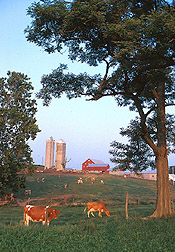This page has been archived and is being provided for reference purposes only. The page is no longer being updated, and therefore, links on the page may be invalid.

An ARS study could help small dairy farms like the one pictured here in western Maryland. Click the image for more information about it.
A Grazing Strategy for Small Dairy Farms
By Don Comis
September 30, 2004
Agricultural Research Service scientists in Ohio are beginning a dairy grazing research and demonstration program to help family dairy farms both in Ohio and nationwide.
The research at the North Appalachian Experimental Watershed in Coshocton is part of an ARS dairy grazing project being done in cooperation with two other ARS facilities, the U.S. Dairy Forage Research Center in Madison, Wis., and the Pasture Systems and Watershed Management Research Unit at University Park, Pa., as well as The Ohio State University (OSU) and OSU's Ohio Agricultural Research and Development Center.
Ohio ranks fourth in the nation for number of dairy herds, but, as with the rest of farming nationwide, dairy farms in Ohio are going up in size and down in number.
This fall, ARS soil scientist Lloyd B. Owens and colleagues at Coshocton are using simple electric fences to create small paddocks to rotate cattle from one part of a pasture to another every day or two. They are testing a system called management-intensive, or rotational, dairy grazing.
ARS scientists will monitor manure runoff and water quality. OSU scientists will check on how different forage grasses and plants hold up under intensive grazing, as well as how the animals fare and the quality of milk from grass-fed cows.
The idea is to spread out the grazing so that cattle are always eating only the freshest growing tips of forage grasses, which are the most nutritious and tastiest parts of the plants. This could help make small dairy farms more profitable by raising the per-cow profit margin. Grazing eliminates the need to provide livestock feed to confined animals, and grazing newly grown forage might also allow more cows per acre, further lowering costs.
This could help alleviate economic pressures on farmers to convert to mega-dairies with 1,000 to 2,000 cows confined to feeding barns. Such large dairies face higher costs, including those associated with manure storage. Rotational grazing may spread manure more evenly in fields, lessening the chances of pollution.
ARS is the U.S. Department of Agriculture's chief scientific research agency.
